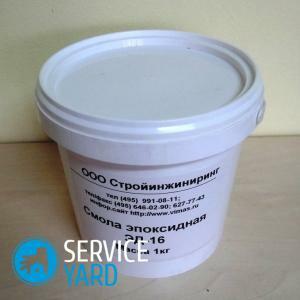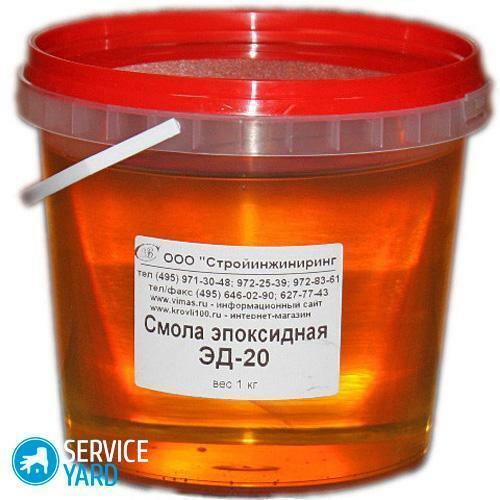
- What you need to know about epoxy resin?
- How to choose the right way?
- How to remove epoxy resin?
- The basic rules for dissolving epoxies:
For sure, those who have ever used epoxy resin or glue on the basis of such a substance have faced such a difficult task as dissolving during work or cleaning after completing the assembly of the desired design. If you are also puzzled by the question than dissolve epoxy, this article is for you.
to the contents ↑What you need to know about epoxy resin?
Before you look for a solvent for epoxy, you need to understand its composition and features. They are included in the following:
- Such glue solutions in the base have 2 components. Under special conditions - the addition of plasticizer, as well as heat treatment, they enter into the reaction. Precisely because of this, polymerization takes place.
- The special demand for such formulations is that in the solidified form the glue is very hard, resistant to mechanical attack and moisture, and it does not lose its special characteristics for more time.
Important! This substance is used not only for gluing, but also for impregnating them with wood, glass and fiberglass. This is done in order to improve their physical and chemical properties and reduce the chance of destruction.
to the contents ↑How to choose the right way?
As the application technique involves preheating the substance, as well as applying it in the form of a liquid to the desired surface, it is hardly possible to do it very clearly and accurately along the border.
Despite its excellent characteristics, it is still possible to dissolve the epoxy resin, and several methods are suitable for this purpose.
Important! The basic principle of removing such a substance is to start the reverse process, and this procedure can damage the main surface. Therefore, before you choose a tool, specify whether it can be used with the main surface, not allowing its destruction.
to the contents ↑How to remove epoxy resin?
To dissolve the epoxy resin, several methods are used:
Scraping with a sharp object
This method is suitable only for the surface to which such a process with direct mechanical action does not affect any destruction.
Important! For metal, this option is categorically contraindicated, as well as painted surfaces. In this case, there is a high probability of scratches and chips, which will further corrode the .
Heating of frozen resin
This method implies the presence of certain skills in working with construction equipment and requires maximum accuracy.
Important! An excellent solution will be the processing of wooden, as well as plastic, unpainted surfaces. They will bear this impact painlessly.
To dissolve the epoxy, proceed as follows:
- Use a degreaser, which does not contain alcohol, to clean the surface.
- Then use a construction hair dryer to heat the resin until it becomes viscous and flowable.
- Once you have achieved the correct consistency of the adhesive mass, remove it with a knife or another suitable object.
- Now you just need to wipe off the remaining small elements of the resin with a cotton pad moistened with the right tool. Here, such an epoxy solvent as acetone is excellent.
Important! During this procedure, do not forget to protect the face, hands, body, so as not to reward yourself with burns.
Solvent dilution
Epoxy resin is a component of many adhesives. It is a viscous and fluid fluid, and it is this property that makes its use not always convenient. The small viscosity of the resin ensures its fluidity, therefore, using a brush or a roller, it is very easy to apply to fiberglass. Porous surfaces are also easily impregnated with it.

Dissolution is performed most often in order to reduce the viscosity of the solution used.
Important! Note that diluting the epoxy significantly affects the characteristics of the final polymer - the strength and water resistance of the surface is significantly reduced.
Most solvents are suitable for diluting such a material, but the following is usually used:
- solvent for varnishes;
- acetone;
- is denatured alcohol.
Important! The volatility of these substances allows them to evaporate very quickly, and not to linger in the resin.
to content ↑Basic rules for the dissolution of epoxies:
- Even a very small amount of solvent significantly reduces the viscosity of the solution used.
- Addition of a solvent reduces the strength of the solidified polymer, and this does not allow its use during the manufacture of structural products.
- The epoxy resin solvent significantly increases the curing time of the polymer mass.
- Diluting substances cause resin shrinkage. It happens that not all the solvent has time to evaporate from the adhesive mass, and that is why it continues to volatilize during the polymerization, as well as after it. This can cause microcracks of the frozen surface.
- Sometimes solvents affect the color of the polymer with which you work.
- The presence of solvent in solution or glue can damage the surface.
We hope that our methods and recommendations will help you cope with the epoxy resin and you will be able to retain its strength characteristics after dilution without damaging the glued objects.



